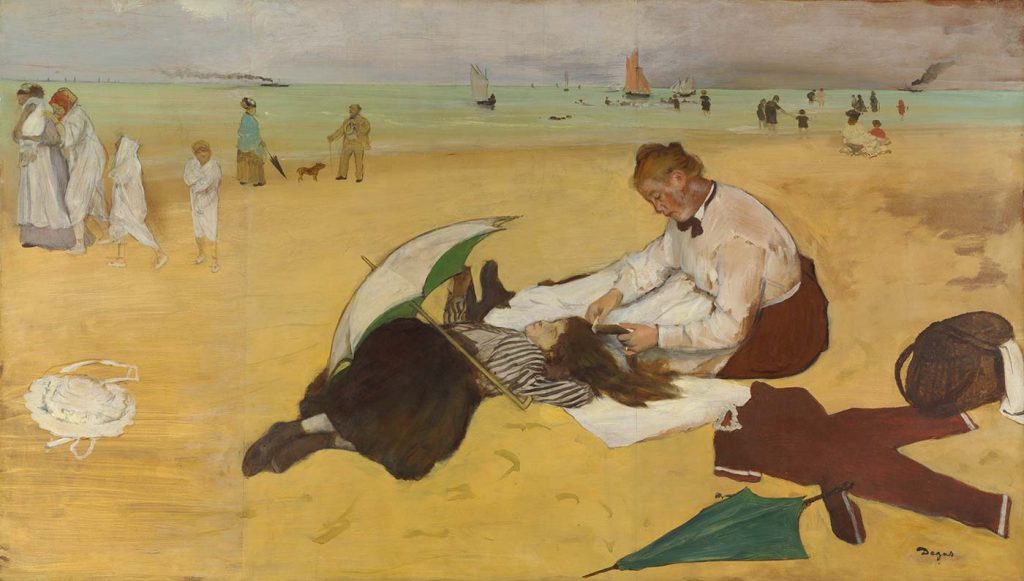
Beach Scene by Edgar Degas was created in 1869 – 1870. The painting is in National Gallery, London. The size of the work is 47,5 x 82,5 cm and is made of oil on paper mounted on canvas.
About the Work
A maid combs the hair of a girl who has been swimming; her bathing suit is stretched out on the ground to dry. Other objects – two parasols, a basket and a summer bonnet – are scattered around them. In the background, a family group – some members wrapped in towels – is leaving the shoreline, as other people stroll on the beach.
The picture was painted with essence – oil paint from which most of the oil has been removed with blotting paper, which is diluted with turpentine to give the effect of watercolour. It is one of four paintings of beach scenes that Degas completed in around 1869. That year he travelled to the northern French coast and made a series of landscapes in pastel. While some of the pastels may have been completed on site, Degas later stated that this picture had been finished in the studio, commenting, ‘the air you breathe in a picture is not necessarily the same as the air you breathe out of doors’. All four beach paintings include young women beside the sea, bathing, attending to their hair or resting.
Small paintings of beach and seaside scenes in resorts such as Trouville were popular with several of Degas’s contemporaries, including Whistler, Boudin and Monet. An immediate precedent was Manet’s Beach at Boulogne (Museum of Fine Arts, Richmond Virginia), from which Degas borrowed various elements. The two artists had a friendly but competitive relationship, and may well have travelled together to the channel coast in 1869.
Both paintings have three horizontal bands for the sandy beach, turquoise-green sea and grey sky. Both also have sailboats in the distance – curiously, smoke from the two steamboats in Degas’s picture blows in opposite directions – and a scattering of bathers and walkers on the beach. Read more in National Gallery London
About the Artist
Edgar Degas (19 July 1834 – 27 September 1917) was a French Impressionist artist famous for his pastel drawings and oil paintings.
Degas also produced bronze sculptures, prints, and drawings. Degas is especially identified with the subject of dance; more than half of his works depict dancers. Although Degas is regarded as one of the founders of Impressionism, he rejected the term, preferring to be called a realist, and did not paint outdoors as many Impressionists did.
Degas was a superb draftsman, and particularly masterly in depicting movement, as can be seen in his rendition of dancers and bathing female nudes. In addition to ballet dancers and bathing women, Degas painted racehorses and racing jockeys, as well as portraits. His portraits are notable for their psychological complexity and their portrayal of human isolation. Read more in Wikipedia
Order a reproduction of this work (printed on canvas)
